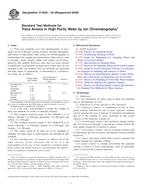Potřebujeme váš souhlas k využití jednotlivých dat, aby se vám mimo jiné mohly ukazovat informace týkající se vašich zájmů. Souhlas udělíte kliknutím na tlačítko „OK“.
ASTM D5542-04(2009)
Standard Test Methods for Trace Anions in High Purity Water by Ion Chromatography
Automaticky přeložený název:
Standardní zkušební metody pro Trace aniontů ve vysoké čistotě vody iontovou chromatografií
NORMA vydána dne 1.5.2009
Informace o normě:
Označení normy: ASTM D5542-04(2009)
Poznámka: NEPLATNÁ
Datum vydání normy: 1.5.2009
Kód zboží: NS-31608
Počet stran: 9
Přibližná hmotnost: 27 g (0.06 liber)
Země: Americká technická norma
Kategorie: Technické normy ASTM
Kategorie - podobné normy:
Anotace textu normy ASTM D5542-04(2009) :
Keywords:
anion, eluant, ion chromatography, trace, Acetate, Anions content, Bromide (ion) analysis, Chloride analysis--water applications, Eluent/elution, Fluoride (ion) analysis, Formate, High-purity water, Iodide ion (soluble) content, Ion chromatography (IC), Nitrite/nitrate content, Phosphate content--water applications, Sulfate content--water, Sulfite content, Trace elements--water analysis, ICS Number Code 71.040.30 (Chemical reagents)
Doplňující informace
| Significance and Use | ||||||||||||||||||||||||||||||||||||
|
The anions fluoride, chloride, and sulfate have been identified as important contributors to corrosion of high pressure boilers, electric power turbines and their associated heat exchangers. Many electric power utilities attempt to reduce these contaminants in their boiler feed water to less than 1 μg/L. In the semiconductor manufacturing process these ions, among others, have been identified as a cause of low product yield and, thus, must be monitored and controlled to levels similar to those required by the electric power industry. Low molecular weight organic acids, such as acetate and formate, have been found in many steam generator feed waters and condensates. They are believed to come from the high temperature breakdown of organic matter found in boiler make up water. It is felt that these organic acids promote corrosion by lowering the pH of boiler waters and may even be corrosive themselves. Such low molecular weight organics may also be produced when ultraviolet light is used to produce bacteria-free water for semiconductor processing. Such polar organic contaminants are suspected of causing reduced semiconductor yields. Phosphates are commonly added to drum boilers in the low mg/L level to precipitate calcium and magnesium and thereby prevent scale formation. Ion chromatography can be used to monitor the concentration of such chemicals in boiler water, as well as detect unwanted carry-over into the steam. |
||||||||||||||||||||||||||||||||||||
| 1. Scope | ||||||||||||||||||||||||||||||||||||
|
1.1 These test methods cover the determination of trace (μg/L) levels of fluoride, acetate, formate, chloride, phosphate, and sulfate in high purity water using ion chromatography in combination with sample preconcentration. Other anions, such as bromide, nitrite, nitrate, sulfite, and iodide can be determined by this method. However, since they are rarely present in significant concentrations in high purity water, they are not included in this test method. Two test methods are presented and their ranges of application, as determined by a collaborative study, are as follows:
A Limit of detection is lowest measurable concentration not reportable as zero at 99 % level of confidence as per EPRI study as cited in Sections 15 and 23. B Insufficient data to calculate limit of detection. 1.2 It is the user's responsibility to ensure the validity of these test methods for waters of untested matrices. 1.3 The common practical range of Test Method A is as follows: chloride, 1 to 100 μg/L, phosphate, 3 to 100 μg/L, and sulfate, 2 to 100 μg/L. 1.4 The common practical range of Test Method B is as follows: fluoride, 1 to 100 μg/L, acetate, 10 to 200 μg/L, and formate, 5 to 200 μg/L. 1.5 The values stated in SI units are to be regarded as standard. No other units of measurement are included in this standard. 1.6 This standard does not purport to address all of the safety concerns, if any, associated with its use. It is the responsibility of the user of this standard to establish appropriate safety and health practices and determine the applicability of regulatory limitations prior to use. 7.1 This test method is optimized for the quantitative determination of trace levels of chloride, phosphate, and sulfate. Anions such as fluoride, acetate, and formate can be detected by this method, but are not reliably resolved from each other. See Fig. 1 for a typical chromatogram. 7.2 Using a concentrated sample volume of 20 mL, the test method is applicable in the range outlined in Section 1. The range of this test method may be extended by concentrating a smaller or a larger sample volume. Be sure not to exceed concentrator column breakthrough volume (see annex). 16.1 This test method is optimized for the quantitative determination of trace levels of fluoride, acetate, and formate in high purity water and in water containing up to 2000 mg/L boron from boric acid. The range of the method is summarized in Section 1. See Fig. 3 for a typical chromatogram. 16.2 This test method does not respond to sulfate, since its elution time is very long. 16.3 Using a concentrated sample volume of 20 mL, the test method is applicable in the range outlined in Section 1. The range of this method may be extended upward by concentrating a smaller sample volume, or downward by concentrating a larger sample volume. When analyzing samples containing high amounts of boric acid (for example, 1 %), the volume concentrated should not exceed 30 mL, so as not to exceed the breakthrough volume for fluoride.
|
||||||||||||||||||||||||||||||||||||
| 2. Referenced Documents | ||||||||||||||||||||||||||||||||||||
|
Odebírejte informace o nově vydaných normách ZDARMA:
Chcete pravidelně odebírat informace o nově vycházejících normách z celého světa a to zcela zdarma?
Přihlašte se k odběru. Vše je velice jednoduché a absolutně ZDARMA.
Na výběr máte vydavatele z celého světa.




 Cookies
Cookies
